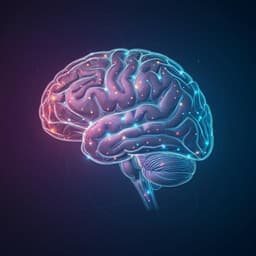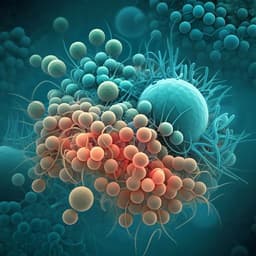
Chemistry
A programmable chemical computer with memory and pattern recognition
J. M. Parrilla-gutierrez, A. Sharma, et al.
Discover the groundbreaking programmable chemical processor developed by researchers Juan Manuel Parrilla-Gutierrez and colleagues at the University of Glasgow. Utilizing a 5x5 array of cells engaged in the Belousov-Zhabotinsky reaction, their innovation can unlock over 2.9 × 10¹⁷ chemical states, showcasing visually detectable memory and a chemical autoencoder capable of performing one million operations per second.
~3 min • Beginner • English
Introduction
The study addresses the limitations of von Neumann architectures—separate processor and memory causing a data bottleneck and reliance on binary electronic switches approaching scaling and power limits. Alternative paradigms (e.g., quantum, coupled-oscillator, reaction–diffusion systems) hint at massively parallel, noise-tolerant computation. Prior chemical systems, especially the Belousov–Zhabotinsky (BZ) reaction, have implemented logic, image processing, pattern recognition, and neuromorphic behaviors but remain problem-specific and poorly programmable. The authors propose a programmable chemical processor where processing and memory co-reside within a fluidically connected array of oscillatory BZ cells. Individual cells are actuated via controllable magnetic stirring to set local oscillation states and frequencies; hydrodynamic coupling mediates intercell communication. Video-based readout and image processing digitize the chemical states, enabling on-demand programmability and dynamic reconfiguration during execution.
Literature Review
The paper surveys unconventional computing based on coupled oscillators across modalities: chemical, chemo-mechanical, spin-torque, and optical, noting issues with weak coupling, desynchronization, and noise, alongside recent progress. Reaction–diffusion computing has solved labyrinth pathfinding, implemented logic gates and Boolean circuits. Specifically for BZ media, prior work demonstrated logic elements and complex circuits, image processing, pattern recognition, optimization, actuation of mechanical/soft-matter systems, and neuromorphic architectures. Architectures span single-phase 2D mappings, multi-channel networks, and multiphase droplets/vesicles. Advances in 3D printing and machine learning suggest hybrid systems where electronic actuation instantiates inputs, chemical media evolve dynamics, and digital vision processes outputs. The reservoir computing framework provides a theoretical basis for leveraging nonlinear, high-dimensional transient dynamics for pattern classification, provided the echo-state property holds.
Methodology
System architecture: A 5×5 grid of fluidically connected BZ reaction cells (initially fabricated as a 7×7 grid with only the central 5×5 used) was 3D-printed (Stratasys Connex, VeroWhitePlus). Each cell housed an 8×3 mm magnetic stir bar above an individually controlled geared DC motor (6V, 200 RPM). Motors were driven by PWM signals (Arduino Mega with Adafruit 16-Channel 12-bit PWM/Servo shield), commanded by a Python-controlled computer. A webcam (Microsoft LifeCam Cinema) recorded the grid from above for real-time analysis.
Chemical system: The BZ reaction used ferroin ([Fe(bpy)3]2+/3+) as the sole catalyst/indicator (red reduced Fe(II), blue oxidized Fe(III)), with sulfuric acid, malonic acid, and potassium bromate as reagents. Stock solutions were prepared as specified (e.g., KBrO3 0.5 M in 1 M H2SO4; H2SO4 1 M; malonic acid 1 M; ferroin prepared via 1,10-phenanthroline and ferrous sulfate solution). Reaction volume ~70 mL filled the arena to 3/4 height. Stirring induces and sustains coherent oscillations; without stirring, oscillations degrade or suppress, enabling external control of local excitation states.
Cell–cell coupling: Two grid designs were tested. With a v-shaped opening between cells (fluid level above opening), oscillations did not propagate, yielding independent cell control (display-like). Removing the v-shaped barriers and leaving only cell corners increased fluid exchange; stirred cells propagated excitation to neighbors, enabling activation of disabled cells via surrounding activity and generating coherent global wave patterns. Hydrodynamic coupling and individually set stirrer speeds permitted control over local phase/frequency and global synchronization. Cells could be designated as active (fast stirring), processing (slow), or inactive (no stirring).
Programmability and timing: Stirrer states (on/off and speed) were individually addressable and dynamically adjustable during execution, allowing time-varying input sequences. BZ oscillations exhibited short-term memory; depending on KBrO3 concentration, up to ~eight spontaneous oscillations could occur post-actuation.
Imaging and preprocessing: Videos (800×600 px, 30 FPS, MP4 in AVI container) were processed frame-by-frame. An SVM (OpenCV) trained on human-labeled data classified each cell's state (blue/excited=1, red/non-excited=0), outputting CSV matrices (25 rows × frames). For pattern datasets, 30-min experiments were sped up 15× (yielding ~3600 frames; first 1000 discarded). Sliding windows were extracted: typical size 30 frames × 25 cells (750 features); windows retained if ≥100 ones, producing 2236 entries across 20 patterns (digits, letters, random), each pattern triplicated (60 CSVs total).
Neural network classifiers: Two CNN pipelines were reported. (1) CNN (TensorFlow 1.15): three conv layers (32@5, 64@3, 128@3) and FC layer with 64 neurons; train/test split 70/30; accuracy 80.5% on test with 30×25 windows (750 features). (2) Deeper CNN with window 20×25 (500 features), train/test split 90/10; architecture: Conv blocks with dropout, interleaved maxpools (up to Conv7), then FC 64 and Softmax; accuracy 92.5% on test. Control experiments with water (no BZ) failed classification, indicating insufficient dynamics.
Reservoir computing framing: The BZ grid served as the reservoir, projecting input motor patterns into high-dimensional, nonlinear temporal responses satisfying the echo-state property; a readout NN decoded to class labels.
Digital encoder benchmark: A digital autoencoder NN was trained to map 5×5 motor patterns to synthesized BZ-like oscillation outputs, which were then fed to the same CNN decoder. Autoencoder: 25 inputs to 625 outputs with hidden dense layers (50–10–50), trained with L2 regularization (1e-5), lr=1e-6, two cycles of 3000 iterations. A separate CNN configuration is also described for numbers 0–9: three conv layers (2 feature maps with kernels 3 and 5; third with 1 map, kernel 3), FC 16, output 10. Estimated digital encoder complexity: ~60 million logic gates per forward pass; by comparison, the chemical platform using 1-minute window data implies on the order of ~1 million logic-gate-equivalent operations per oscillation (as a proxy for encoding complexity).
Data handling: Activation states recorded into CSVs; center-of-mass tracking of blue intensity used to visualize wave propagation histories for different dynamic input sequences. Source code available at https://github.com/croningp/BZ1.
Key Findings
- Programmable chemical processor: A 5×5 grid of BZ cells with individually addressable stirring achieves on-demand programmability; stirrer on/off and speed set local oscillations and, via hydrodynamic coupling, shape global wave patterns.
- Large state space: More than 2.9 × 10^17 distinct chemical states are accessible, arising from discretizable oscillation amplitudes across cells and time.
- Memory: The BZ medium exhibits short-term memory; depending on bromate concentration, up to ~eight unforced oscillations can occur after actuation, enabling volatile memory within the same processing space.
- Pattern recognition (reservoir computing): The platform consistently maps input motor patterns to reproducible spatiotemporal wave patterns that are machine-decodable.
• With 20 classes (digits, letters, random), CNN achieved 80.5% accuracy (750-feature windows, 70/30 split) and up to 92.5% accuracy with a deeper CNN (500-feature windows, 90/10 split).
• Control with water failed classification, supporting the necessity of BZ dynamics to project inputs into a higher-dimensional manifold.
- Digital encoder equivalence: A trained digital autoencoder can replace the chemical medium to generate BZ-like oscillations that are correctly decoded by the same CNN, demonstrating that the chemical platform functions as a chemical encoder. Estimated digital forward pass ~60 million logic gates; mapping from 1-minute chemical window suggests ~1 million logic-gate-equivalent operations per oscillation (and the abstract notes ≈1 million operations per second capability).
- Spatial coupling control: Removing intercell barriers enabled activation of disabled cells via neighbors and formation of coherent global patterns; with barriers, cells behaved independently (display-like), confirming tunable coupling.
- Reconfigurability: Dynamic input sequences during execution produce distinct, history-dependent wave trajectories, consistent with recurrent chemical state behavior.
Discussion
The findings demonstrate that a fluidically connected array of oscillating BZ cells can serve as a programmable processing medium where computation and memory co-reside, mitigating the von Neumann bottleneck at the architectural level. By externally actuating local oscillations and exploiting hydrodynamic coupling, the system encodes digital inputs into rich spatiotemporal chemical dynamics which can be reliably decoded via machine learning. The consistent, class-distinguishable responses to input patterns, together with short-term memory, align with the echo-state property of reservoir computing, enabling effective pattern recognition within the chemical substrate. Benchmarking against a digital autoencoder shows functional equivalence of the chemical medium as an encoder, supporting its role as a chemical processor. The vast multi-level state space and inherent parallelism suggest potential for low-power, high-dimensional computing tasks that are difficult to model or simulate explicitly, such as complex dynamics evaluation or physical encoding. While current readout and control are hybrid (electronic actuation and vision-based decoding), the approach outlines a pathway to more autonomous chemical computing by enhancing intrinsic reaction–diffusion coupling and optimizing physical architectures for direct chemical information processing.
Conclusion
This work introduces a programmable chemical computer based on a 5×5 array of BZ oscillators with individually addressable stirring, enabling on-demand programming, short-term memory, and pattern recognition via reservoir computing. The platform achieves a massive chemical state space (>2.9×10^17), reproducible wave-based encodings, and machine-decodable outputs with up to 92.5% classification accuracy. A digital autoencoder benchmark corroborates the platform’s role as a chemical encoder with an estimated complexity on the order of millions of logic-gate-equivalent operations per oscillation/second. The system highlights a viable route toward non–von Neumann, low-power, highly parallel chemical computation and suggests new algorithmic paradigms that exploit electron-transfer-driven dynamics. Future work should aim to: (i) miniaturize cells to harness spontaneous reaction–diffusion coupling (reducing reliance on mechanical stirring), (ii) co-design physical architectures using machine learning to minimize electronic post-processing, and (iii) extend task complexity and scalability while integrating more autonomous chemical input/output interfaces.
Limitations
- Temporal constraints: Reagent depletion limits the operational window; after preparation, ~10 minutes stabilization with low visibility is followed by ~30 minutes of optimal oscillatory behavior.
- Speed: Computation is tied to the oscillation period (~40–60 seconds per oscillation), much slower than electronic processors, though oscillation frequency can be tuned via reagent ratios.
- Hybrid dependencies: Current implementation depends on electronic actuation (motors) and electronic readout with machine learning for decoding; human interpretation of complex patterns is difficult without ML.
- Environmental sensitivity: Oscillation behavior depends on precise chemical concentrations and coupling geometry; weak or strong coupling must be tuned (e.g., by modifying intercell openings) for desired behavior.
- Volatile memory: Chemical memory is short-term (on the order of several oscillations) and decays without continuous actuation.
- Reproducibility across batches: Sensitivity to reagent source/quality and preparation may affect consistency, requiring careful standardization.
Related Publications
Explore these studies to deepen your understanding of the subject.







